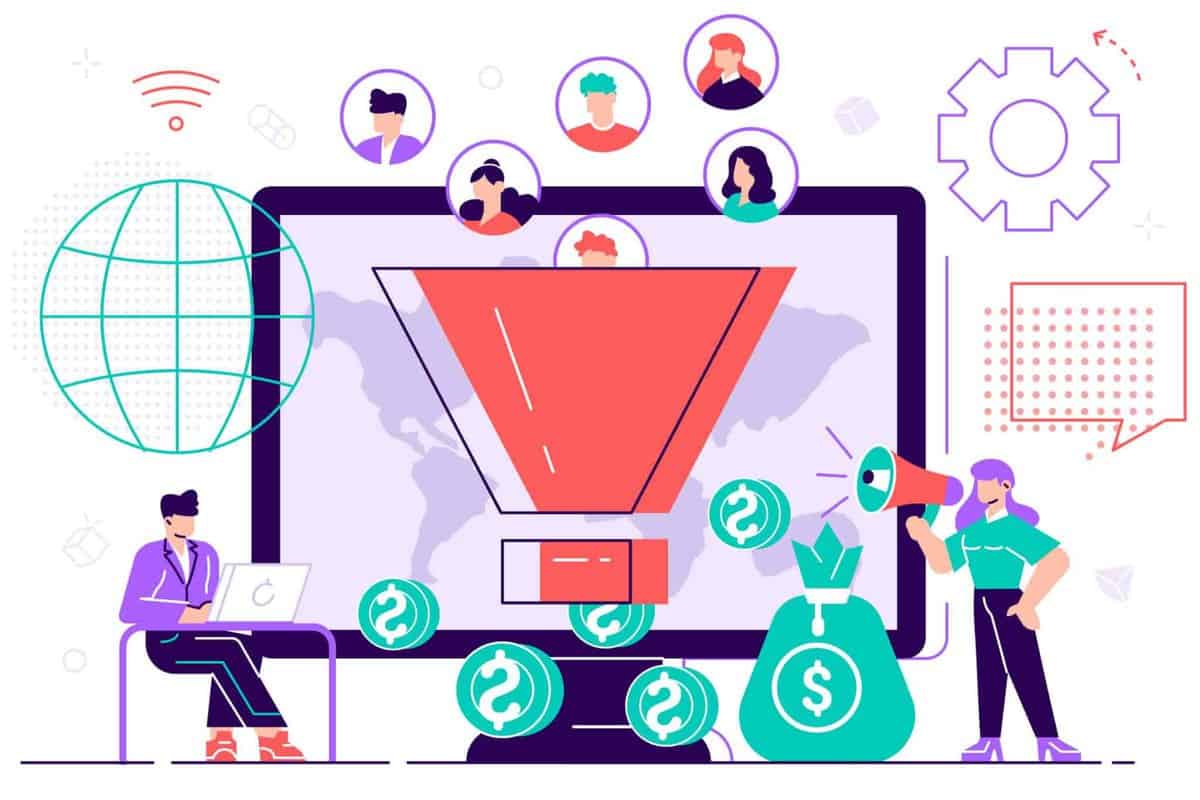In today’s competitive business world, companies are constantly looking for ways to optimize their strategies and maximize their growth. Two approaches that have gained widespread popularity are CRO (Conversion Rate Optimization) methodology and predictive personalization. While both focus on improving the customer experience, they do so through different methods that, when combined, can generate exceptional results.
This article delves into the CRO methodology and predictive personalization, exploring their definitions, benefits, examples of success, practical tips for implementation, and how they can work together to drive business growth.
What is CRO (Conversion Rate Optimization)?
Conversion rate optimization (CRO) is a strategic process that seeks to increase the percentage of visitors to a website or mobile application who take a desired action1. These actions, also known as conversions, can include purchasing a product, subscribing to a newsletter, filling out a form, or downloading an app.2. At its core, CRO focuses on improving the user experience with the goal of converting visitors into customers.
To better understand CRO, it is essential to adopt a customer-centric approach3. This involves understanding what motivates users, what barriers they encounter, and what convinces them to convert. It’s not just about numbers and percentages, but about the people behind that data.
A crucial aspect of CRO is A/B testing2. These tests compare two versions of a website element, such as a headline or call-to-action button, to determine which converts more. By validating hypotheses through A/B testing, businesses can continually optimize their websites for maximum performance.
To calculate a website’s conversion rate, you divide the total number of conversions by the total number of visitors who interacted with the website, web page or content in a defined time period. The result is multiplied by 100 to obtain a percentage4. For example, if an online store received 50 sales and had 1000 visitors last month, the sales conversion rate would be 5% (50 / 1000 x 100 = 5%).
Importantly, CRO has its roots in direct response marketing, an approach that emphasizes tracking, testing, and continuous improvement.5. With the rise of e-commerce and web analytics, CRO has become an essential tool for businesses looking to
Master the secrets of a successful brand Download it free
What is Predictive Personalization?
Predictive personalization is a marketing technique that uses artificial intelligence (AI), machine learning, and data analytics to understand customer needs and provide personalized experiences in real time.6. Unlike traditional personalization, which reacts to explicit customer requests, predictive personalization anticipates customer needs based on data such as their location, demographics, or browsing behavior.7.
There are different approaches to personalization. Rules-based personalization manually defines the conditions for displaying specific content to visitors, while machine learning-based personalization uses algorithms to analyze visitor behavior and personalize the website accordingly.8. Predictive personalization builds on the latter approach, harnessing the power of AI to deliver personalized experiences at scale.
Predictive personalization is based on the analysis of different types of data to understand and predict customer behavior. This data includes: 9
- Past behavior: Information about the customer’s previous interactions with the company, such as purchase history and website visits.
- Current behavior: Data about customer actions in real time, such as the pages they visit and the products they view.
- THN Interactions: Information about how the customer interacts with the company’s tools and messages, such as the emails they open and the ads they click on.
- External data: Market data on competitors, sector trends and other relevant factors.
By analyzing this data, predictive personalization can deliver highly relevant content, offers, and recommendations to each customer, increasing the likelihood that they will engage with the brand and make a purchase. In fact, predictive personalization has been shown to increase revenue by 22% and email open rates by 83% compared to traditional personalization tactics.10.
How CRO Methodology Increases Conversions and Business Growth
The CRO methodology can have a significant impact on business growth by increasing conversions and improving customer experience. By optimizing conversion rates, businesses not only increase their revenue but also see a higher return on investment (ROI) on their marketing efforts.11.
Some of the key benefits of CRO include:
- Higher income: By converting more visitors into customers, businesses can increase sales without needing to increase website traffic.12. This translates into a higher return on marketing investment and sustainable business growth.
- Increased customer retention: A positive user experience fosters customer loyalty and increases the likelihood that they will return12. By eliminating pain points in the customer journey, CRO creates a smoother, more satisfying experience that fosters brand loyalty.
- Lower customer acquisition costs: By optimizing conversions, businesses can reduce the cost of acquiring new customers11. This allows companies to allocate their marketing resources more efficiently and maximize their return on investment.
- Better customer knowledge: CRO provides valuable insights into user behavior, allowing businesses to better understand their target audience13. These insights can be used to improve customer segmentation, personalize offers, and create more effective marketing campaigns.
- More effective marketing: By understanding what works and what doesn’t, businesses can optimize their marketing campaigns for better results.12. CRO provides concrete data on the performance of different website elements and marketing campaigns, allowing companies to make data-driven decisions and continually improve their strategies.
Furthermore, CRO and SEO (search engine optimization) are closely related.14. While SEO focuses on driving traffic to a website, CRO makes sure that traffic is converted into valuable actions. A website optimized for conversions also tends to perform better in search rankings because user engagement metrics, such as time on site and bounce rate, improve.
A key element for CRO success is intuitive user experience (UX) design.4. If visitors cannot easily find what they are looking for or navigate the website comfortably, they are more likely to leave the site without converting. Good UX design keeps visitors interested and makes conversion easier.
CRO can also be used to identify the most profitable revenue sources and optimize marketing efforts accordingly.15. By analyzing the performance of different traffic channels, businesses can identify those that generate the highest conversion rates and focus their efforts on those channels to maximize return on investment.
How Predictive Personalization Improves Customer Experience and Increases Sales
Predictive personalization offers a number of advantages for companies looking to improve customer experience and increase sales. By anticipating customer needs, businesses can create more relevant, engaging, and convenient experiences that drive loyalty and conversions.
- More convenient shopping experiences: Customers can find the products and services they want more easily16. Predictive personalization eliminates the need for customers to search through a sea of options, presenting them with relevant products and offers that fit their needs and preferences.
- Mayor engagement: Personalized content is more relevant and engaging for customers, increasing their engagement with the brand17. By delivering content that aligns with customer interests, predictive personalization creates a more engaging experience that encourages engagement and exploration.
- Greater loyalty: Customers feel valued when they receive personalized experiences, building brand loyalty18. By demonstrating that they understand customer needs and preferences, companies can build stronger relationships that translate into greater loyalty and greater long-term customer value.
- Higher conversion rates: Predictive personalization can significantly increase conversion rates by giving customers what they want at the right time16. By presenting relevant offers and recommendations in a timely manner, businesses can influence purchasing decisions and increase conversions.
- Greater usability of the product: AI can analyze user behavior to recommend the right products or features, making it easier for customers to get the most out of what’s on offer18. This improves the overall user experience and increases customer satisfaction.
- Dynamic price and promotion management: Predictive personalization allows companies to offer dynamic pricing and personalized promotions based on customer behavior and preferences19. This not only improves customer experience but also optimizes revenue by offering the right price at the right time.
- Optimization of marketing campaigns: AI can help predict the success of marketing campaigns and tailor messages to individual preferences20. This allows companies to allocate their marketing resources more efficiently and maximize return on investment.
Practical Tips for Implementing CRO and Predictive Personalization
Implementing CRO and predictive personalization may seem overwhelming, but there are concrete steps companies can take to get started:
For CRO:
- Define conversion goals: Determine what actions you want your website visitors to take. This may include purchasing a product, subscribing to a newsletter or filling out a contact form.
- Analyze the conversion funnel: Identify pain points in the customer journey where visitors leave the website. Use web analytics tools to track user behavior and determine where the highest abandonment rates occur.
- Collect user data: Use web analytics tools, such as heat maps and session recordings, to understand user behavior12. Heat maps show where users click on a page, while session recordings allow you to see how users interact with the website in real time.
- Create hypothesis: Formulate ideas on how to improve website elements to increase conversions. This may include changes to website design, content, calls to action, or navigation.
- Test the hypotheses: Conduct A/B testing to compare different versions of a web page to determine which performs best. Be sure to test one element at a time to isolate the impact of each change.
- Revise and repeat: Analyze test results and make adjustments to continually optimize conversions13. CRO is an ongoing process that requires constant monitoring and data-driven optimization.
For predictive personalization:
- Collect data: Collect customer data from various sources such as website interactions, social media, and email marketing campaigns. The more data you collect, the more accurate your predictions will be.
- Analyze data: Use AI and machine learning tools to identify patterns and trends in customer behavior. These tools can help you understand what products customers are interested in, what offers they are most likely to accept, and what communication channels they prefer.
- Predict customer behavior: Use analyzed data to predict future customer actions. This will allow you to anticipate their needs and offer them personalized experiences at the right time.
- Personalize the shopping experience: Deploy predictive personalization strategies to provide customers with personalized search results, product recommendations, and relevant emails7. Ensure personalization is consistent across all communication channels.
Examples of Companies Using CRO and Predictive Personalization
| Enterprise | Approach | Results |
|---|---|---|
| Starbucks | Predictive personalization to send offers in real time through your mobile application. | 30% increase in conversion rates. |
| Netflix | Machine learning to analyze viewing habits and recommend personalized content. | 93% retention rate. |
| Amazon | Predictive personalization to offer product recommendations. | Significant increase in sales. |
| Sephora | Virtual assistants to recommend products based on skin tone and purchase history. | Personalized shopping experience. |
Limitations and Challenges of CRO and Predictive Personalization
While CRO and predictive personalization offer great potential, they also present challenges that companies must consider:
CRO:
- Resistance to change: It can be difficult to convince companies to change established practices, even when data suggests it is necessary11. This may require a change in company culture and greater openness to experimentation.
- Limited Features: Implementing CRO can require time, money, and expertise that some companies don’t have11. It is important to allocate appropriate resources and seek external support if necessary.
- Data Overload: It can be difficult to analyze and interpret the large amount of data generated by CRO testing11. It is essential to have the right tools and expertise to analyze data and extract actionable insights.
Predictive Personalization:
- Data quality: The accuracy of the predictions depends on the quality of the data. Incomplete or inaccurate data can lead to erroneous predictions22. It is crucial to ensure data quality and use data cleaning and validation techniques.
- Overfit: Predictive models can overfit training data, leading to poor performance on new data22. It is important to use cross-validation and regularization techniques to avoid overfitting.
- Bias and fairness: Predictive models may reflect existing biases in the data, which can lead to discriminatory results22. It is essential to be aware of potential biases in data and take steps to mitigate them.
- Interpretability: It can be difficult to understand how predictive models arrive at a particular prediction22. It is important to use model interpretability techniques to understand the reasoning behind predictions.
- Data privacy: Collection and use of customer data for predictive personalization must comply with privacy laws23. It is essential to obtain customer consent, securely protect data, and be transparent about how data is used.
How CRO and Predictive Personalization Work Together
CRO and predictive personalization can complement each other to achieve better results. By combining these two strategies, companies can create highly optimized and personalized online experiences that drive engagement, loyalty and conversions.
Predictive personalization can be used to improve user segmentation in A/B testing, allowing companies to deliver more relevant experiences to different customer groups.24. For example, by using predictive personalization to identify customers who are most likely to make a purchase, companies can target A/B tests to those customers and optimize web pages to maximize conversions.
Additionally, CRO can help optimize the performance of predictive personalization strategies by identifying pain points in the customer journey and removing barriers to conversion.24. By analyzing user behavior and optimizing website design, businesses can ensure that personalized experiences are as effective as possible.
AI can also be used to improve landing page design25. AI-powered tools can predict where users’ attention will be focused, allowing CRO specialists to strategically place elements like calls to action (CTAs) and key messages to optimize conversions.
Additionally, personalization can improve customer satisfaction and loyalty after conversion26. By offering personalized post-conversion experiences, such as relevant product recommendations or personalized thank you messages, businesses can foster customer retention and encourage repeat purchases.
Trends and Technologies in CRO and Predictive Personalization
The field of CRO and predictive personalization is constantly evolving. Some of the latest trends and technologies include:
CRO:
- Generative AI: Used to automate A/B testing, summarize test logs, and suggest future steps27. This allows CRO professionals to optimize web pages more quickly and efficiently.
- Augmented reality (AR) and virtual reality (VR): Used to provide personalized, immersive experiences that influence purchasing decisions27. For example, e-commerce companies can use virtual reality to allow customers to “try on” clothing or visualize furniture in their homes before purchasing.
- Higher testing speed: Companies test more frequently to quickly adapt to changing visitor preferences27. This requires more agile testing tools and processes.
- Inclusive UX Design: Websites are created that offer a positive experience to a broader audience27. This includes taking into account the needs of people with disabilities and ensuring that the website is accessible to all.
Predictive Personalization:
- Hyperpersonalization: Real-time data, AI and automation are used to deliver personalized interactions instantly28. This allows companies to tailor experiences to individual customer actions and preferences in real time.
- Predictive Personalization: The customer’s intention is anticipated to offer solutions even before they request them29. This requires deep analysis of customer behavior and the use of predictive models to anticipate future needs.
- Privacy-aware personalization: First-party and zero-party data collection is prioritized, where customers voluntarily share their preferences29. This allows companies to personalize experiences while respecting customer privacy.
Latest technologies in predictive personalization:
- Contextual awareness: Predictive personalization is evolving to incorporate contextual factors such as location, time of day, and local events30. This allows companies to offer even more relevant and personalized experiences.
- AI-powered chatbots: Chatbots are becoming more sophisticated and can be used to offer personalized customer service, answer questions, and guide customers through the purchasing process.31.
Conclusions
CRO methodology and predictive personalization are two powerful tools that can help companies grow in today’s competitive market. By understanding customer behavior, optimizing online experiences, and delivering personalized interactions, businesses can increase conversions, improve customer satisfaction, and drive business growth.
To achieve optimal results, it is essential to take a holistic approach that combines CRO and predictive personalization. This implies:
- Make data-driven decisions: Use data from web analytics, A/B testing, and predictive modeling to make informed decisions about website optimization and personalization.
- Continuous optimization: CRO and predictive personalization are ongoing processes that require constant monitoring, testing, and adjustments to ensure strategies remain effective.
- Customer-centric approach: Understanding customer needs, motivations, and preferences is critical to the success of CRO and predictive personalization.
While there are challenges in implementing these strategies, the potential benefits are significant. By staying up to date with the latest trends and technologies, such as generative AI, virtual reality, and contextual awareness, businesses can make the most of CRO and predictive personalization to achieve success in today’s market.
Sources cited
1. www.optimizely.com, accessed: February 19, 2025, https://www.optimizely.com/optimization-glossary/conversion-rate-optimization/#:~:text=Conversion%20rate%20optimization%20(CRO)%20is,B%20testing%20and%20multivariate%20testing
2. What is conversion rate optimization (CRO)? – Adjust, acceso: febrero 19, 2025, https://www.adjust.com/glossary/conversion-rate-optimization/
3. What is Conversion Rate Optimization (CRO)? A Complete Guide – Contentsquare, acceso: febrero 19, 2025, https://contentsquare.com/guides/conversion-rate-optimization/
4. What Is Conversion Rate Optimization (CRO)? Strategies and Tools (2024) – Shopify, acceso: febrero 19, 2025, https://www.shopify.com/blog/120261189-conversion-rate-optimization
5. Conversion rate optimization – Wikipedia, accessed: February 19, 2025, https://en.wikipedia.org/wiki/Conversion_rate_optimization
6. www.fastsimon.com, accessed: February 19, 2025, https://www.fastsimon.com/ecommerce-wiki/personalization/what-is-predictive-personalization/#:~:text=Predictive%20personalization%20is%20a%20powerful,personalized%20experiences%20in%20real%20time.
7. What Is Predictive Personalization? – Fast Simon, acceso: febrero 19, 2025, https://www.fastsimon.com/ecommerce-wiki/personalization/what-is-predictive-personalization/
8. Predictive Vs Rules-Based Personalization: What’s The Difference? – Clearcode, acceso: febrero 19, 2025, https://clearcode.cc/blog/machine-learning-vs-rules-based-personalization-whats-difference/
9. Predictive Personalization – The Hotels Network, acceso: febrero 19, 2025, https://thehotelsnetwork.com/en/predictive-personalization
10. Predictive Personalization Strategies – Listrak, accessed: February 19, 2025, https://www.listrak.com/white-papers/predictive-personalization-strategies
11. Dominating CRO Marketing to Boost Your Business Conversions – Bonhomie Creative, acceso: febrero 19, 2025, https://bonhomiecreative.com/insights/dominating-cro-marketing-to-boost-your-business-conversions/
12. Ultimate Guide to Conversion Rate Optimization (CRO) Strategies for Your Business, acceso: febrero 19, 2025, https://www.jaymehta.co/blog/ultimate-guide-conversion-rate-optimization-cro-strategies/
13. Conversion Rate Optimization: What It Is and Why It Matters for Your Business? – S2W Media, acceso: febrero 19, 2025, https://www.s2wmedia.com/blogs/conversion-rate-optimization
14. Conversion Rate Optimization (CRO): 8 Ways To Get Started – HubSpot Blog, acceso: febrero 19, 2025, https://blog.hubspot.com/marketing/conversion-rate-optimization-guide
15. CRO Strategy Development [By Business Growth Stage] – Edgemesh, acceso: febrero 19, 2025, https://edgemesh.com/blog/what-role-does-conversion-rate-optimization-play-in-your-growth-strategy
16. Predictive Personalization | Acxiom, accessed: February 19, 2025, https://www.acxiom.com/predictive-personalization/
17. How to Use Predictive Customer Analytics to Increase Conversions – Custify Blog, acceso: febrero 19, 2025, https://www.custify.com/blog/predictive-customer-analytics-increase-conversions/
18. AI Personalization in Customer Experience: Measuring ROI Effectively – Bloomreach, acceso: febrero 19, 2025, https://www.bloomreach.com/en/blog/ai-personalization-in-customer-experience
19. 15 Ways Predictive Analytics Can Help Businesses Boost Their CX – Forbes, acceso: febrero 19, 2025, https://www.forbes.com/councils/forbestechcouncil/2023/08/24/15-ways-predictive-analytics-can-help-businesses-boost-their-cx/
20. Mastering AI Driven Personalization: Top Strategies for Modern Customer Experience (CX), acceso: febrero 19, 2025, https://www.nice.com/info/mastering-ai-driven-personalization-top-strategies-for-modern-customer-experience-cx
21. Unveiling the Secrets: How Top Companies Utilize Predictive Analytics | Pecan AI, acceso: febrero 19, 2025, https://www.pecan.ai/blog/how-companies-use-predictive-analytics/
22. Challenges And Limitations Of Predictive Models – FasterCapital, acceso: febrero 19, 2025, https://fastercapital.com/topics/challenges-and-limitations-of-predictive-models.html
23. The Benefits, Challenges and Risks of Predictive Analytics for Your Application, acceso: febrero 19, 2025, https://insightsoftware.com/blog/the-benefits-challenges-and-risks-of-predictive-analytics-for-your-application/
24. Optimization vs Personalization: How They Differ, Can Collaborate, and Learn from Each Other – Experimentation Heroes, acceso: febrero 19, 2025, https://experimentationheroes.com/nieuws/optimization-vs-personalization-how-they-differ-can-collaborate-and-learn-from-each-other/
25. How To Improve Your CRO With Predictive AI – CXL, acceso: febrero 19, 2025, https://cxl.com/blog/improve-landing-page-predictive-ai/
26. The Complete Guide To Personalization In CRO | AWA Digital, acceso: febrero 19, 2025, https://www.awa-digital.com/blog/personalization-in-cro/
27. Top 14 CRO Trends Shaping the Digital Landscape [2025] | VWO, accessed: February 19, 2025, https://vwo.com/conversion-rate-optimization/conversion-rate-optimization-trends/
28. The Future of Personalization Is Here: Trends to Look Out for in 2025 – Shopify, acceso: febrero 19, 2025, https://www.shopify.com/enterprise/blog/personalization-trends
29. Future Personalization Trends Transforming Digital Experience in 2025 – Nudge, acceso: febrero 19, 2025, https://www.nudgenow.com/blogs/personalization-trends-transforming-digital-experience
30. Personalization Technology in 2025 Explained (+ Upcoming Trends) – Fast Simon, acceso: febrero 19, 2025, https://www.fastsimon.com/ecommerce-wiki/personalization/personalization-technology-explained-upcoming-trends/
31. 2024’s Top Trends in Personalized Customer Service in the Age of AI – Custify Blog, acceso: febrero 19, 2025, https://www.custify.com/blog/2024-top-trends-personalized-customer-service/



